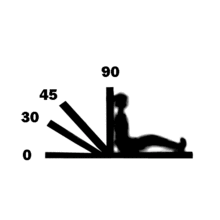Fowler's position
In medicine, Fowler's position is a standard patient position in which the patient is seated in a semi-sitting position (45-60 degrees) and may have knees either bent or straight. Fowler's position includes angles between 30 and 90 degrees. "Variations in the angle are denoted by high Fowler, indicating an upright position at approximately 90 degrees; Fowler, indicating an angle between 45 and 60 degrees; semi-Fowler, 30 to 45 degrees; and low Fowler, where the head is slightly elevated." [1]. It is an intervention used to promote oxygenation via maximum chest expansion and is implemented during events of respiratory distress. Fowler's position facilitates the relaxing of tension of the abdominal muscles, allowing for improved breathing. In immobile patients and infants, the Fowler's position alleviates compression of the chest that occurs due to gravity. Fowler's position increases comfort during eating and other activities, is used in postpartum women to improve uterine drainage, and in infants when signs of respiratory distress are present. Fowler's position is also used when oral or nasal gastric feeding tubes have been implemented as it minimizes the risk of aspiration. Peristalsis and swallowing are aided by the effect of gravitational pull.

There are several types of Fowler's positions: Low, Semi, Standard, and High Fowler's. Low Fowler's position is when the head of bed is elevated 15-30 degrees, Semi-Fowler's position is 30-45 degrees, Standard Fowler's is 45-60 degrees, and High Fowler's position is 60-90 degrees.
It is named for George Ryerson Fowler,[2] who saw it as a way to decrease the mortality of peritonitis: Accumulation of purulent material under the diaphragm led to rapid systemic sepsis and septic shock, whereas pelvic abscesses could be drained through the rectum.[3]
References
- LaFleur Brooks, Myrna and Danielle (2018). Exploring Medical Language: A Student Directed Approach (10th Ed). Elsevier. p. 68.
- synd/3035 at Who Named It?
- G. R. Fowler. Diffuse septic peritonitis, with special reference to a new method of treatment, namely, the elevated head and trunk posture, to facilitate drainage into the pelvis, with a report of nine consecutive cases of recovery. The Medical Record, New York, 1900, 57: 617-623, 1029-1931.